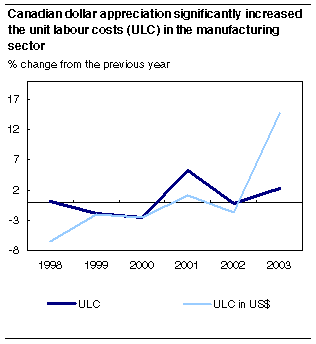
















 |
|
 |                |
Information identified as archived is provided for reference, research or recordkeeping purposes. It is not subject to the Government of Canada Web Standards and has not been altered or updated since it was archived. Please "contact us" to request a format other than those available.

|

Friday, May 21, 2004 Labour productivity performance by industry2003Labour productivity in the manufacturing sector slowed markedly in 2003. Productivity growth in manufacturing advanced at 1.2% in 2003, compared with 2.8% in 2002. Ten of the 20 industries forming the manufacturing sector recorded a decline in productivity, while another quarter recorded a slowdown in productivity growth. The stronger Canadian dollar in 2003 had a negative impact on the output of manufacturing industries, which decreased by 0.5% in 2003. At the same time, hours worked in this sector declined at a more pronounced pace (-1.7%). During this period, the rapid appreciation of the Canadian dollar pressured Canadian exporters of manufacturing goods to adjust their operating costs. Much like the manufacturing sector, the majority of other industries (11 of 15) in the business sector recorded a decline or a slower productivity growth. In contrast, sectors such as agriculture, forestry, fishing and hunting; professional services; as well as arts, entertainment and recreation; and other commercial services, experienced an acceleration of productivity growth in 2003. The year 2003 was marked by several negative shocks that affected economic activity and contributed to a lacklustre 0.1% growth in the business sector's productivity growth. This is the smallest gain of the last six years, during which productivity grew at 1.9% on average. Productivity growth is an essential contributor to the prosperity of Canadians over the long run. It measures the efficiency with which labour is employed in the production process. Nearly all industries experienced a slowdown in productivityIn 2003, labour productivity growth varied significantly across industry groups, ranging from a 6.3% decline in the mining and oil and gas extraction sector to an 8.8% increase in the agriculture, forestry, fishing and hunting sector. Following the 2.2% drop in 2002, labour productivity rebounded in 2003 in agriculture, forestry, fishing and hunting, where it grew at 8.8%. This is the largest increase of any sector and is attributable to better harvests in Western Canada. With a 3.9% productivity growth in 2003, wholesale trade ranked second, down from the 6.6% recorded in 2002. They were followed by other industry groups, including other services (+3.6%), professional services (+2.9%), arts, entertainment and recreation (+2.2%), and retail trade (+1.6%). With the exception of the agriculture, forestry, fishing and trapping industry, manufacturing was the only other industry group in the goods-producing sector that recorded a productivity increase in 2003. Over the last three years, the average annual growth of labour productivity in manufacturing advanced at 2.0%, about half of the 4.4% experienced between 1997 and 2000. The increase in manufacturing productivity in 2003 was mainly driven by the productivity recovery in the computer and electronic products (+8.4%) and the electrical equipment, appliance and component manufacturing industries (+1.3%). These two industries had reported a productivity decline during the two previous years. In the manufacturing sector as a whole, output per hour worked increased in 7 of the 20 three-digit industry groups; the annual gains ranging from 0.8% to 5.7%. Within this group, non-metallic mineral products, printing and related support activities and primary metal manufacturing all experienced productivity gains of at least 3.5%. Despite the housing market bubble, finance, insurance, real estate, rental and leasing experienced no productivity gain in 2003. The seven remaining two-digit industries registered a productivity decline in 2003. Unit labour cost increases in most of the industriesUnit labour cost, an indicator that measures how hourly compensation changed relative to labour productivity, deteriorated in most industries in 2003. As a result of the lacklustre labour productivity, 11 of the 15 major industrial groups recorded increases in unit labour costs in 2003. Industries that posted the best performance in terms of unit labour cost-agriculture, forestry, fishing and hunting-were generally the ones with the highest productivity gains. Following the 9.7% increase in their unit labour cost in 2002, the agriculture, forestry, fishing and hunting experienced a significant 16.5% drop in its unit labour cost in 2003. Crop and animal production, and forestry and logging were the sectoral sources of this reduction. Other declines were observed in arts, entertainment and recreation (-3.6%), followed by accommodation and food services (-2.8%) and wholesale trade (-0.7%). 
In contrast, unit labour cost growth accelerated in most of the other two-digit industries of the business sector. In manufacturing, unit labour cost increased by 2.3% in 2003, following a slight 0.2% decline in 2002. When the exchange rate is taken into account, the appreciation of the Canadian dollar led to a strong increase in the unit labour cost in manufacturing. Manufacturing unit labour costs increased by 14.7% in 2003 for US dollars. This strong appreciation in such a short period has contributed to the deterioration in the competitiveness of manufacturing exports to the United States. A series of tables on productivity growth and related variables for the business sector and its 15 main industries will be available in a new dynamic publication Canadian Productivity Accounts (15-003-XIE, free), which will be available on May 26. Available on CANSIM: tables 383-0013 and 383-0015. Definitions, data sources and methods: survey number 1402. For more information about productivity, see the Overview and description of publications page online or contact Jean-Pierre Maynard (613-951-3654; fax: 613-951-3292; maynard@statcan.gc.ca), Micro-economic Analysis Division.
| ||||||||||||||||||||||||||||||||||||||||||||||||||||||||||||||||||||||||||||||||||||||||||||||||||||||||||||||||||||||||||||||||||||||||||||||||||||||||||||||||||||||||
|
|
|